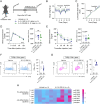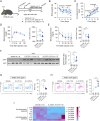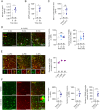Interleukin-2 improves insulin sensitivity through hypothalamic sympathetic activation in obese mice
- PMID: 39367382
- PMCID: PMC11453069
- DOI: 10.1186/s12974-024-03244-y
Interleukin-2 improves insulin sensitivity through hypothalamic sympathetic activation in obese mice
Abstract
Background: IL-2 regulates T cell differentiation: low-dose IL-2 induces immunoregulatory Treg differentiation, while high-dose IL-2 acts as a potent activator of cytotoxic T cells and NK cells. Therefore, high-dose IL-2 has been studied for use in cancer immunotherapy. We aimed to utilize low-dose IL-2 to treat inflammatory diseases such as obesity and insulin resistance, which involve low-grade chronic inflammation.
Main body: Systemic administration of low-dose IL-2 increased Treg cells and decreased inflammation in gonadal white adipose tissue (gWAT), leading to improved insulin sensitivity in high-fat diet-fed obese mice. Additionally, central administration of IL-2 significantly enhanced insulin sensitivity through the activation of the sympathetic nervous system. The sympathetic signaling induced by central IL-2 administration not only decreased interferon γ (IFNγ) + Th1 cells and the expression of pro-inflammatory cytokines, including Il-1β, Il-6, and Il-8, but also increased CD4 + CD25 + FoxP3 + Treg cells and Tgfβ expression in the gWAT of obese mice. These phenomena were accompanied by hypothalamic microgliosis and activation of pro-opiomelanocortin neurons. Furthermore, sympathetic denervation in gWAT reversed the enhanced insulin sensitivity and immune cell polarization induced by central IL-2 administration.
Conclusion: Overall, we demonstrated that IL-2 improves insulin sensitivity through two mechanisms: direct action on CD4 + T cells and via the neuro-immune axis triggered by hypothalamic microgliosis.
Keywords: Adipose tissue inflammation; Hypothalamic microglia; Insulin resistance; Interleukin-2; Pro-opiomelanocortin (POMC) neurons; Sympathetic nervous system.
© 2024. The Author(s).
Conflict of interest statement
The authors declare no competing interests.
Figures






Similar articles
-
IL-21 is a major negative regulator of IRF4-dependent lipolysis affecting Tregs in adipose tissue and systemic insulin sensitivity.Diabetes. 2014 Jun;63(6):2086-96. doi: 10.2337/db13-0939. Epub 2014 Jan 15. Diabetes. 2014. PMID: 24430438
-
Modulation of Sirt1 and FoxO1 on Hypothalamic Leptin-Mediated Sympathetic Activation and Inflammation in Diet-Induced Obese Rats.J Am Heart Assoc. 2021 Jul 20;10(14):e020667. doi: 10.1161/JAHA.120.020667. Epub 2021 Jul 14. J Am Heart Assoc. 2021. PMID: 34259031 Free PMC article.
-
[Effects of bifid triple viable on chronic low-grade inflammation in obese mice induced by high fat diet].Wei Sheng Yan Jiu. 2022 Sep;51(5):797-802. doi: 10.19813/j.cnki.weishengyanjiu.2022.05.020. Wei Sheng Yan Jiu. 2022. PMID: 36222043 Chinese.
-
Monounsaturated fatty acid-enriched high-fat diets impede adipose NLRP3 inflammasome-mediated IL-1β secretion and insulin resistance despite obesity.Diabetes. 2015 Jun;64(6):2116-28. doi: 10.2337/db14-1098. Epub 2015 Jan 27. Diabetes. 2015. PMID: 25626736
-
Tregs facilitate obesity and insulin resistance via a Blimp-1/IL-10 axis.JCI Insight. 2021 Feb 8;6(3):e140644. doi: 10.1172/jci.insight.140644. JCI Insight. 2021. PMID: 33351782 Free PMC article.
Cited by
-
Etiology, Pathophysiology, and Treatment Strategies in the Prevention and Management of Metabolic Syndrome.Arch Intern Med Res. 2024;7(4):273-283. doi: 10.26502/aimr.0184. Epub 2024 Oct 28. Arch Intern Med Res. 2024. PMID: 39574946 Free PMC article.
-
Neuro-immune Interactions in Metabolic Regulation: Brain and Adipose Tissue Crosstalk.J Obes Metab Syndr. 2025 Jul 30;34(3):182-195. doi: 10.7570/jomes25050. Epub 2025 Jul 25. J Obes Metab Syndr. 2025. PMID: 40707168 Free PMC article. Review.
-
The Intriguing Roles of Cytokines in Metabolic Dysfunction-Associated Steatotic Liver Disease: A Narrative Review.Curr Obes Rep. 2025 Aug 12;14(1):65. doi: 10.1007/s13679-025-00657-5. Curr Obes Rep. 2025. PMID: 40794228 Free PMC article. Review.
-
Effects of low-intensity endurance exercise and low-dose lithium chloride administration on muscle atrophy in high-fat diet induced obese rats.Phys Act Nutr. 2025 Jun;29(2):19-25. doi: 10.20463/pan.2025.0010. Epub 2025 Jun 30. Phys Act Nutr. 2025. PMID: 40765068 Free PMC article.
-
Obesity: pathophysiology and therapeutic interventions.Mol Biomed. 2025 Apr 25;6(1):25. doi: 10.1186/s43556-025-00264-9. Mol Biomed. 2025. PMID: 40278960 Free PMC article. Review.
References
-
- Morgan DA, Ruscetti FW, Gallo R. Selective in vitro growth of T lymphocytes from normal human bone marrows. Science. 1976;193:1007–8. 10.1126/science.181845. - PubMed
-
- Rosenberg SA, Yang JC, Topalian SL, Schwartzentruber DJ, Weber JS, Parkinson DR, et al. Treatment of 283 consecutive patients with metastatic melanoma or renal cell cancer using high-dose bolus interleukin 2. JAMA. 1994;271:907–13. 10.1001/jama.1994.03510360033032. - PubMed
-
- Rosenberg SA, Lotze MT, Muul LM, Leitman S, Chang AE, Ettinghausen SE, et al. Observations on the systemic administration of autologous lymphokine-activated killer cells and recombinant interleukin-2 to patients with metastatic cancer. N Engl J Med. 1985;313:1485–92. 10.1056/NEJM198512053132327. - PubMed
-
- Fyfe G, Fisher RI, Rosenberg SA, Sznol M, Parkinson DR, Louie AC. Results of treatment of 255 patients with metastatic renal cell carcinoma who received high-dose recombinant interleukin-2 therapy. J Clin Oncol. 1995;13:688–96. 10.1200/JCO.1995.13.3.688. - PubMed
MeSH terms
Substances
Grants and funding
LinkOut - more resources
Full Text Sources
Medical
Research Materials
Miscellaneous

